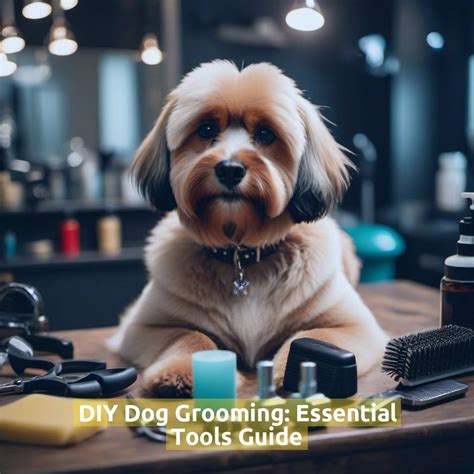Introduction
Dog grooming is an essential aspect of pet ownership that ensures the health, comfort, and overall well-being of our canine companions. Regular grooming not only keeps your dog looking and feeling its best but also helps prevent health issues, such as skin infections, mats, and parasites.

Professional Grooming vs. DIY
Many dog owners face the dilemma of whether to opt for professional grooming services or handle the task themselves. While professional grooming can provide a comprehensive and convenient experience, it can also be expensive. On the other hand, DIY grooming can save money but requires time, patience, and a certain level of skill.
Benefits of Professional Grooming:
- Comprehensive services (bathing, brushing, nail trimming, ear cleaning, etc.)
- Use of high-quality products and equipment
- Time-saving and convenient
- Experienced groomers can identify and address potential health issues
Benefits of DIY Grooming:
- Cost-effective
- Can be done at your own pace
- Gives you more control over the grooming process
- Can be a bonding experience with your dog
Essential Grooming Tips for Optimal Dog Health
1. Bathing:
- Frequency: 1-2 times per month or as needed
- Use a gentle shampoo specifically formulated for dogs
- Avoid using human shampoo as it can be harsh on your dog’s skin
- Rinse thoroughly to remove all soap residue
2. Brushing:
- Frequency: Daily for long-haired dogs, 2-3 times per week for short-haired dogs
- Use a slicker brush for long hair and a bristle brush for short hair
- Brush in the direction of hair growth to remove loose hair and prevent mats
3. Nail Trimming:
- Frequency: As needed, typically every 2-4 weeks
- Use sharp nail clippers and trim the nails at an angle to avoid cutting into the quick
- If you are not comfortable trimming your dog’s nails, ask your veterinarian or a professional groomer for assistance
4. Ear Cleaning:
- Frequency: Weekly or bi-weekly
- Use a cotton ball or gauze pad dipped in a gentle ear cleaning solution
- Wipe away any visible debris or discharge without going too deep into the ear canal
- If you notice any redness, swelling, or odor in your dog’s ears, consult your veterinarian
5. Dental Care:
- Brush your dog’s teeth regularly using a soft-bristled toothbrush and dog-safe toothpaste
- Offer dental chews or toys that help clean teeth
- Schedule regular dental check-ups with your veterinarian to prevent dental disease
Advanced Grooming Techniques
1. Stripping:
- A technique used on certain breeds with wiry coats
- Involves removing dead hairs by hand or using a tool to maintain the coat’s texture and prevent matting
2. Scissoring:
- Cutting the hair with scissors to create a specific style or shape
- Requires specific training and experience to achieve professional results
3. Dyeing:
- Coloring a dog’s hair for aesthetic purposes
- Only recommended for specific breeds and should be done by a professional groomer
The Importance of Regular Grooming
Regular grooming is not merely a cosmetic endeavor; it is crucial for the overall health and well-being of dogs.
- Prevents Skin Infections: Grooming removes bacteria, dirt, and other debris that can accumulate on the skin and lead to infections.
- Reduces Matting: Brushing and combing helps prevent hair from matting, which can cause pain and discomfort and attract parasites.
- Detects Health Issues: During grooming, you can check for lumps, bumps, or other signs of potential health problems and address them promptly.
- Promotes Bonding: Grooming can be a bonding experience for you and your dog, strengthening the human-animal bond.
How to Groom Your Dog Step-by-Step
Materials:
- Shampoo and conditioner
- Towels
- Brush or comb
- Nail clippers
- Ear cleaning solution
- Cotton balls or gauze pads
Step 1: Gather Your Materials
Step 2: Wet Your Dog’s Fur
Step 3: Apply Shampoo
Step 4: Rinse Thoroughly
Step 5: Apply Conditioner (Optional)
Step 6: Brush or Comb
Step 7: Dry Your Dog
Step 8: Trim Nails
Step 9: Clean Ears
Tips and Tricks for Successful Dog Grooming
- Start grooming your dog from an early age to make it a positive experience.
- Use treats or praise to reinforce good behavior during grooming sessions.
- Be patient and gentle, especially with anxious dogs.
- If your dog is particularly resistant to grooming, consider consulting a professional groomer.
- Stay informed about the specific grooming needs of your dog’s breed.
- Use high-quality grooming products designed for dogs.
- Schedule regular grooming appointments to maintain your dog’s health and appearance.
Conclusion
Dog grooming is an essential aspect of pet ownership that plays a vital role in the health, comfort, and overall well-being of dogs. Whether you choose professional grooming services or opt for DIY grooming, it is important to follow best practices to ensure the best possible care for your furry friend. By implementing the tips and advice outlined in this article, you can maintain your dog’s coat, skin, and overall health for years to come.





















